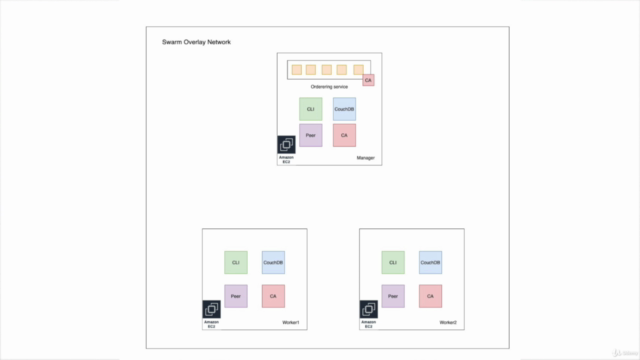Learn to Deploy Hyperledger Fabric v2.2 on Multihost

Why take this course?
🌐 Deploy Hyperledger Fabric on Multi-VM, Multi-Org: A Comprehensive Guide
🚀 Course Headline: Master the deployment of Hyperledger Fabric networks across multiple virtual machines and organizations with this in-depth course!
📘 Course Description:
In this hands-on course, you'll dive deep into setting up a robust Hyperledger Fabric network on multiple hosts, leveraging different cloud environments. We'll explore the intricacies of deploying fabric applications with a specific configuration that includes:
- 3 Virtual Machines (VMs): Choose any cloud provider of your preference to host these VMs.
- Multi-Org Setup: Configure 3 different Organizational entities, each with its own Peer and one central Ordering Service Organization with 5 Ordering Nodes.
- Certificates Authority: Generate certificates and private keys for each organization's CA (3 CAs in total).
- NodeJS API Server: Learn to set up a NodeJS server for invoking Chaincode operations.
🛠️ Multi-host Deployment Methodologies:
Understanding the deployment across multiple hosts is crucial. As Hyperledger Fabric components operate as containers, ensuring they communicate effectively is a key challenge. This course covers various methods to achieve this:
-
Static IP Addresses: Assign host IPs to containers and configure them using
extra_hostsin yourdocker-composefiles. These entries will reflect in the/etc/hostsfile on the respective hosts. While static, this approach can be complex to manage dynamically. -
Docker Swarm: Utilize Docker's native orchestration tool for a more dynamic setup. Docker Swarm provides an overlay network that allows containers across various hosts to communicate seamlessly. This method maintains your original configuration with minimal changes and eliminates the need for static IPs.
-
Kubernetes (k8s): The most popular container orchestration tool, Kubernetes offers a similar mechanism as Docker Swarm but requires a more advanced setup and understanding of its ecosystem.
👩💻 Hands-On Learning Experience:
Throughout this course, you'll gain practical experience in:
- VM Creation & Network Setup: Configure 3 VMs and set up their network interfaces.
- Docker Swarm Network Creation: Establish a Docker Swarm network to facilitate communication across hosts.
- Certificate & Private Keys Creation: Use Certificates Authority to generate security credentials for your organizations and Ordering Service.
- Channel Artifacts Creation: Produce the necessary artifacts to form new channels for secure data exchange.
- CLI Tools Setup: Install command-line interface tools tailored to each organization's needs.
- Channel Creation & Org Joining: Create and join channels across the VMs, ensuring that each organization is properly integrated.
- Chaincode Installation & Approval: Install chaincode (smart contracts) for each organization and get it approved.
- Commit and Invoke Chaincode Transactions: Learn to commit new versions of your chaincode and invoke transactions to trigger smart contract logic.
- API Server Creation: Set up a NodeJS container that will serve as an interface for interacting with the Hyperledger Fabric network.
- Hyperledger Explorer Setup: Finally, configure Hyperledger Explorer to visualize and interact with your deployed contracts and data on the blockchain.
By the end of this course, you'll have a solid understanding of deploying a Hyperledger Fabric network across multiple hosts and managing it effectively. Whether you're an enterprise developer, a DevOps engineer, or a blockchain enthusiast, this course will equip you with the skills to manage multi-host networks confidently.
🚀 Embark on your journey to master Hyperledger Fabric deployment today! 🚀
Course Gallery




Loading charts...